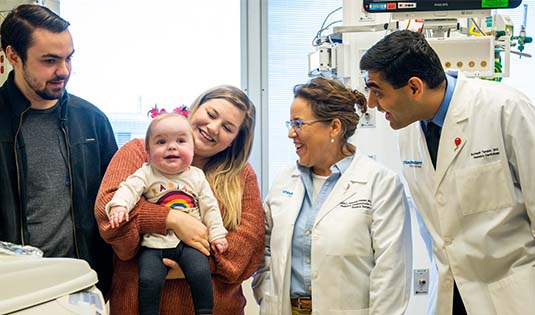Understanding a child's congenital heart defect can be challenging for families. To aid teaching and understanding, the Children's Health℠ CICU team created Bedside Hearts -- a tool that provides illustrations of a child's anatomy before and after their intervention. Results have been encouraging: families now request the illustrations and 70% of surveyed clinicians said that Bedside Hearts helped or changed their practice.
Learn more about Bedside Hearts.
Background
The survival rate for congenital heart patients has increased significantly due to advances in cardiac intensive care and cardiac surgery/interventions (Jenkins & Larsen, 2016).
The CICU team recognized that congenital heart disease (CHD) education at the bedside can be challenging in a high acuity setting.
Bedside Hearts was developed to resource clinicians in a fast-paced environment.
This tool provides an illustration of the patient’s cardiac anatomy before and after intervention.
The diagrams are utilized to support CHD education for direct care providers and families.
Per the Nottingham Model, accepted health care practices must be challenged in order to develop innovative skills and knowledge to support and develop pediatric practitioners (Smith, 1995).
Lead By
Lindsey Daigle, BSN, RN
Susi Hupp, MD, MSCR
NaShawn Finley, MBA-HM, BSN, RN, CCRN-K
Objective
Provide a resource diagram tool that is readily available for bedside clinicians to further develop their knowledge of congenital heart defects.
Method
A RN Team leader was assigned to the project and prepared a diagram for each patient.
The diagrams are placed at each patient’s bedside and readily available for teaching.
The project began with a few simpler cardiac defects pre-operatively.
The congenital heart diagram is placed at each patient’s bedside upon admission.
The bedside nurse reviews the diagram and will seek out resources for further clarification.
We expanded on the project to include post-surgical or post intervention hearts.
Post-procedure, the diagram is updated with the repair changes.
Results
The Bedside Heart tool is utilized by clinical staff and has increased real time teaching.
Families request these diagrams to increase their own knowledge on their child’s defect. Therefore, the diagrams promote family-centered care.
The RN Team Leader has created a nurse-led work group to support the increase demand for all patients to have bedside heart diagrams.
A post project survey was conducted. Results demonstrated that 70% of bedside clinicians voiced that bedside hearts helped or changed their practice. (See Figure 1)
Conclusions
Bedside heart diagrams have improved cardiac defect education and supports direct care providers to confidently teach congenital heart defects that are individualized to each patient.
Families are intrigued by the visual diagrams and prompted to ask more specific questions about the patient’s anatomy and diagnosis.
The diagrams follow the patients throughout their hospital stay. Therefore, the educational process is ongoing.
Bedside Hearts are migrating outside of the CICU to overflow areas such as the NICU.
Bedside Hearts have promoted individualized treatment plans.
References
Illustrations referenced from http://www.chd-diagrams.com
Smith, F. (1995). Children’s nursing in practice: The Nottingham Model. Hoboken, NJ: Wile-Blackwell.


